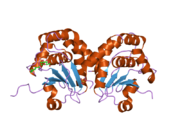- DUSP15
-
Dual specificity phosphatase 15 
PDB rendering based on 1yz4.Available structures PDB 1yz4 Identifiers Symbols DUSP15; FLJ40111; VHY External IDs MGI: 1934928 HomoloGene: 33586 GeneCards: DUSP15 Gene Gene Ontology Molecular function • protein tyrosine phosphatase activity
• protein binding
• protein tyrosine/serine/threonine phosphatase activity
• hydrolase activityCellular component • cytoplasm
• plasma membraneBiological process • protein dephosphorylation Sources: Amigo / QuickGO Orthologs Species Human Mouse Entrez 128853 252864 Ensembl ENSG00000149599 ENSMUSG00000042662 UniProt Q9H1R2 Q8R4V2 RefSeq (mRNA) NM_001012644.1 NM_145744 RefSeq (protein) NP_001012662.1 NP_665687 Location (UCSC) Chr 20:
30.44 – 30.46 MbChr 2:
152.77 – 152.78 MbPubMed search [1] [2] Dual specificity protein phosphatase 15 is an enzyme that in humans is encoded by the DUSP15 gene.[1][2]
The protein encoded by this gene belongs to the non-receptor class of the protein-tyrosine phosphatase family. The encoded protein has both protein-tyrosine phophatase activity and serine/threonine-specific phosphatase activity, and therefore is known as a dual specificity phosphatase. Three transcript variants, encoding two different isoforms have been found for this gene.[2]
References
- ^ Alonso A, Narisawa S, Bogetz J, Tautz L, Hadzic R, Huynh H, Williams S, Gjorloff-Wingren A, Bremer MC, Holsinger LJ, Millan JL, Mustelin T (Jul 2004). "VHY, a novel myristoylated testis-restricted dual specificity protein phosphatase related to VHX". J Biol Chem 279 (31): 32586–91. doi:10.1074/jbc.M403442200. PMID 15138252.
- ^ a b "Entrez Gene: DUSP15 dual specificity phosphatase 15". http://www.ncbi.nlm.nih.gov/sites/entrez?Db=gene&Cmd=ShowDetailView&TermToSearch=128853.
Further reading
- Yoon TS, Jeong DG, Kim JH, et al. (2006). "Crystal structure of the catalytic domain of human VHY, a dual-specificity protein phosphatase.". Proteins 61 (3): 694–7. doi:10.1002/prot.20642. PMID 16170801.
- Gerhard DS, Wagner L, Feingold EA, et al. (2004). "The status, quality, and expansion of the NIH full-length cDNA project: the Mammalian Gene Collection (MGC).". Genome Res. 14 (10B): 2121–7. doi:10.1101/gr.2596504. PMC 528928. PMID 15489334. http://www.pubmedcentral.nih.gov/articlerender.fcgi?tool=pmcentrez&artid=528928.
- Ota T, Suzuki Y, Nishikawa T, et al. (2004). "Complete sequencing and characterization of 21,243 full-length human cDNAs.". Nat. Genet. 36 (1): 40–5. doi:10.1038/ng1285. PMID 14702039.
- Strausberg RL, Feingold EA, Grouse LH, et al. (2003). "Generation and initial analysis of more than 15,000 full-length human and mouse cDNA sequences.". Proc. Natl. Acad. Sci. U.S.A. 99 (26): 16899–903. doi:10.1073/pnas.242603899. PMC 139241. PMID 12477932. http://www.pubmedcentral.nih.gov/articlerender.fcgi?tool=pmcentrez&artid=139241.
- Deloukas P, Matthews LH, Ashurst J, et al. (2002). "The DNA sequence and comparative analysis of human chromosome 20.". Nature 414 (6866): 865–71. doi:10.1038/414865a. PMID 11780052.
- Dias Neto E, Correa RG, Verjovski-Almeida S, et al. (2000). "Shotgun sequencing of the human transcriptome with ORF expressed sequence tags.". Proc. Natl. Acad. Sci. U.S.A. 97 (7): 3491–6. doi:10.1073/pnas.97.7.3491. PMC 16267. PMID 10737800. http://www.pubmedcentral.nih.gov/articlerender.fcgi?tool=pmcentrez&artid=16267.
PDB gallery Esterase: protein tyrosine phosphatases (EC 3.1.3.48) Class I Classical PTPsReceptor type PTPs (PTPRA, PTPRB, PTPRC, PTPRD, PTPRE, PTPRF, PTPRG, PTPRH, PTPRJ, PTPRK, PTPRM, PTPRN, PTPRN2, PTPRO, PTPRQ, PTPRR, PTPRS, PTPRT, PTPRU, PTPRZ)
Non receptor type PTPs (PTPN1, PTPN2, PTPN3, PTPN4, PTPN5, PTPN6, PTPN7, PTPN9, PTPN11, PTPN12, PTPN13, PTPN14, PTPN18, PTPN20, PTPN21, PTPN22, PTPN23MAPK phosphatases (MKPs) (DUSP1, DUSP2, DUSP4, DUSP5, DUSP6, DUSP7, DUSP8, DUSP9, DUSP10, DUSP16, MK-STYX)
CDC14s (CDC14A, CDC14B, CDKN3, PTP9Q22)
Atypical DSPs (DUSP3, DUSP11, DUSP12, DUSP13A, DUSP13B, DUSP14, DUSP15, DUSP18, DUSP19, DUSP21, DUSP22, DUSP23, DUSP24, DUSP25, DUSP26, DUSP27, EMP2A, RNGTT, STYX)
Phosphatase and tensin homologs (PTENs) (PTEN, TPIP, TPTE, TNS, TENC1)
Myotubularins (MTM1, MTMR2, MTMR3, MTMR4, MTMR5, MTMR6, MTMR7, MTMR8, MTMR9, MTMR10, MTMR11, MTMR12, MTMR13, MTMR14, MTMR15)Class II Class III Class IV Categories:- Human proteins
- Chromosome 20 gene stubs
Wikimedia Foundation. 2010.

